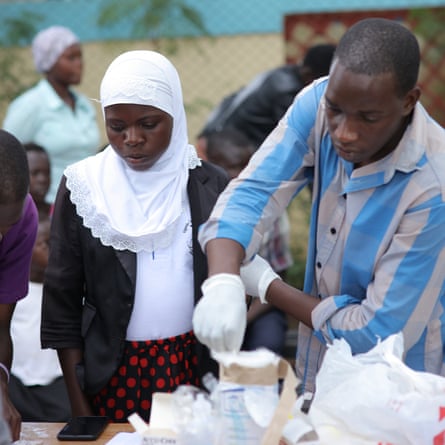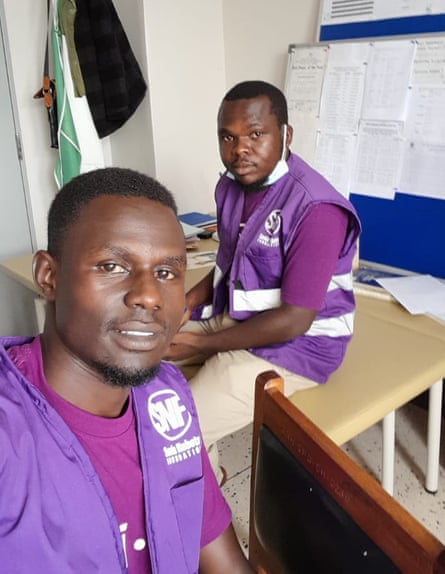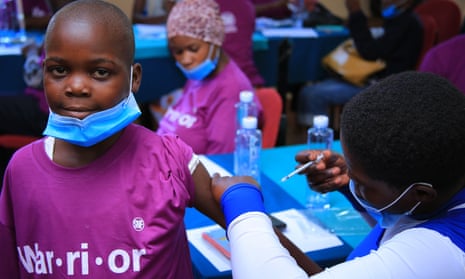On a night bus out of Kampala, the Ugandan capital, a 12-year-old child was constantly asking her uncle for water. She drank so much that finally she wet herself. Dankan Onzima, on his way home from a conference, was sitting behind the girl.
“I felt bad and touched with what was happening to her,” Onzima says. “I had to wait until my destination, but they were going beyond my stop, so I asked the driver to give me two minutes to talk to the caretaker of the child and the driver allowed.”
He asked the girl’s uncle to take her to the diabetes clinic at Arua regional referral hospital, in northern Uganda, where Onzima works as a “warrior coordinator”, helping children with type 1 diabetes (T1D) – or warriors, as the hospital refers to them – get treatment and learn to use an insulin pen.
Quick GuideA common condition
Show
The human toll of non-communicable diseases (NCDs) is huge and rising. These illnesses end the lives of approximately 41 million of the 56 million people who die every year – and three quarters of them are in the developing world.
NCDs are simply that; unlike, say, a virus, you can’t catch them. Instead, they are caused by a combination of genetic, physiological, environmental and behavioural factors. The main types are cancers, chronic respiratory illnesses, diabetes and cardiovascular disease – heart attacks and stroke. Approximately 80% are preventable, and all are on the rise, spreading inexorably around the world as ageing populations and lifestyles pushed by economic growth and urbanisation make being unhealthy a global phenomenon.
NCDs, once seen as illnesses of the wealthy, now have a grip on the poor. Disease, disability and death are perfectly designed to create and widen inequality – and being poor makes it less likely you will be diagnosed accurately or treated.
Investment in tackling these common and chronic conditions that kill 71% of us is incredibly low, while the cost to families, economies and communities is staggeringly high.
In low-income countries NCDs – typically slow and debilitating illnesses – are seeing a fraction of the money needed being invested or donated. Attention remains focused on the threats from communicable diseases, yet cancer death rates have long sped past the death toll from malaria, TB and HIV/Aids combined.
'A common condition' is a Guardian series reporting on NCDs in the developing world: their prevalence, the solutions, the causes and consequences, telling the stories of people living with these illnesses.
Tracy McVeigh, editor
As Onzima suspected, the girl had T1D and is now receiving free insulin and has a glucometer to keep track of her blood glucose levels.
“Now I am happy that the child is under treatment,” says Onzima. “I closely monitor people around me for any ignored signs and symptoms of T1D.”
Onzima, 24, was diagnosed at the Arua clinic in 2015 – a day he calls “the happiest moment of my life” – after months of not understanding what was wrong. At one point, typhoid and malaria were suspected. It left him feeling “lost, alone and scared, urinating all the time, scared to be outside my house just in case I urinate on myself, losing weight”.
Although Onzima now has to carry a glucometer and insulin flex pen, the treatment meant he could pursue his education – he is now in his final year at Uganda’s Muni University.

The Arua clinic is among 31 facilities across Uganda participating in a new scheme helping T1D patients, spearheaded by the Sonia Nabeta Foundation (SNF). The foundation uses Uganda’s network of motorcycle taxis, or boda-bodas, to deliver insulin and other supplies to patients in the most remote areas.
The Covid pandemic and lockdown exacerbated the vulnerabilities of low-income children with T1D, making it impossible for some to access medication.
“In Uganda, the lockdown comprised of a public transportation ban and a 2pm curfew for cargo deliveries. Uganda [had] the world’s longest school lockdown and some of the most stringent Covid restrictions,” says Vivian Nabeta, SNF’s founder.
“In normal circumstances, children from low-income households face difficulties accessing essential supplies from their healthcare centres. Our data has revealed that children sometimes travel up to 5.5 hours round trip to get to and from the clinic for essential supplies, with the major part of the trip on foot.”
Onzima said the use of boda-bodas has bridged the distribution gap, and transformed “how the warriors manage their sugar levels”.
“With home visits, we get to see the warrior in his or her home, see the food he or she eats, see the family and understand better how the warrior is living and how we can help,” he says.

The SNF was set up in 2016 after Nabeta’s sister, Sonia, died due to hypoglycemia, a T1D complication. Initially, she began organising four-day peer-to-peer education camps, and helped with scholarships for primary school students, before launching the boda-boda project last year, reaching 2,000 children.
More than 420 million people across the globe have diabetes, particularly in low- and middle-income countries, according to the World Heath Organization. A chronic and metabolic disease characterised by elevated levels of blood sugar, diabetes is responsible for about 1.5 million global deaths a year.
Type 2 diabetes, the most prevalent form, is often linked to lifestyle choices, whileT1D is a genetic condition often developed during childhood in which the pancreas produces little or no insulin by itself.
“In Africa, children with T1D face suboptimal outcomes and premature deaths due to a variety of reasons, including lack of access to essential medical supplies and – perhaps most importantly – the failure to address the social determinants of health, including factors like poverty, psychosocial barriers, education,” Nabeta says. Only four paediatric endocrinologists operate across Uganda.
“Our work has illustrated that it is not enough to provide insulin, syringes and a glucometer if the child is surrounded by abject poverty, food insecurity, illiteracy and other barriers towards good clinical outcomes. It has illustrated that addressing the social determinants of health and psychosocial barriers is paramount,” says Nabeta.
She said children have died from a hypoglycemic attack simply because families did not have any sugary item at home to stop it, while in other households distrust over modern medication has to be overcome.
One 17-year-old died, despite being on the SNF programme, because his family took his insulin away, resorting to “traditional medicine or going off to prayer crusades hoping the child will be healed”.
Prossy Lanyero, a teenage T1D patient at Lacor hospital clinic in Gulu, gets drugs through the boda-boda project. “Transport used to be a very big problem because I am a good distance away from the clinic,” she says.
“I used to have a hard time following my appointment date. I used to ask the nurse to give me insulin for two or three months, but it would go bad because I have no refrigerator to properly store the insulin. I would use the bad insulin anyway because of transport problems,” she says.
“In the past my family used to carry most of the burden of my care and I would feel bad but I feel that some of the weight has been lifted so now they can focus on my other needs too.”
Lucy Akwero, the mother of a 14-year-old T1D patient in Amuru, says her family struggled to find money for hospital travel – and her son even stopped going to school because it.
“We were always anxious and worried, and my son was sad and hopeless,” she says. “Sometimes I would even sell our own food when it is approaching my son’s clinic appointment day. We do not have to worry about clinic appointments any more, my son now speaks good English, he is confident and happy.”
Sign up for a different view with our Global Dispatch newsletter – a roundup of our top stories from around the world, recommended reads, and thoughts from our team on key development and human rights issues, delivered to your inbox every two weeks:
